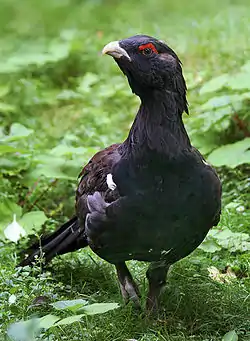| Tetrao[1] | |||
| Linnaeus, 1758[2] | |||
 Przedstawiciel rodzaju – głuszec zwyczajny (T. urogallus) | |||
| Systematyka | |||
| Domena | |||
|---|---|---|---|
| Królestwo | |||
| Typ | |||
| Podtyp | |||
| Gromada | |||
| Podgromada | |||
| Infragromada | |||
| Rząd | |||
| Rodzina | |||
| Podrodzina | |||
| Plemię | |||
| Rodzaj |
Tetrao | ||
| Typ nomenklatoryczny | |||
|
Tetrao urogallus Linnaeus, 1758 | |||
| Synonimy | |||
|
| |||
| Gatunki | |||
| |||
Tetrao – rodzaj ptaków z podrodziny bażantów (Phasianinae) w rodzinie kurowatych (Phasianidae).
Zasięg występowania
Morfologia
Długość ciała samców 80–115 cm, samic 59–75 cm; masa ciała samców 3300–6500 g, samic 1440–2500 g[8].
Systematyka
Etymologia
- Tetrao (Tetras): łac. tetrao, tetraonis „ptak łowny”, nazwa nadana zarówno cietrzewiowi jak i głuszcowi, od gr. τετραων tetraōn, τετραωνος tetraōnos „niezidentyfikowany ptak”, być może ptak łowny[9].
- Urogallus: epitet gatunkowy Tetrao urogallus Linnaeus, 1758; częściowa, homofoniczna interpretacja niem. Auerhahn lub Auerhenne oznaczającego „górski kogut” (por. gr. oυρα oura „ogon”; łac. gallus „kogut”)[10]. Gatunek typowy: Tetrao urogallus Linnaeus, 1758.
- Capricalea: ang. Capercaillie „głuszec”, od gael. capull coille „leśny koń”[11]. Gatunek typowy: Capricalea arborea C.T. Wood, 1837 (= Tetrao urogallus Linnaeus, 1758).
- Grygallus: Gessner w 1555 w swoim dziele Historiæ animalium[12] roku użył terminów „Grygallus major” i „Grygallus minor” odpowiednio dla samic głuszca i cietrzewia, uważając je za oddzielne od samców gatunki. „Grygallus” to jego klasyczna interpretacja miejscowej, szwajcarskiej nazwy Grügelhahn (gr. γρυζω gruzō „narzekać”; łac. gallus „kogut”)[13]. Gatunek typowy: Tetrao urogallus Linnaeus, 1758.
Podział systematyczny
Do rodzaju należą następujące gatunki[14]:
- Tetrao urogallus – głuszec zwyczajny
- Tetrao urogalloides – głuszec czarnodzioby
Przypisy
- ↑ Tetrao, [w:] Integrated Taxonomic Information System (ang.).
- ↑ C. Linnaeus: Systema naturae per regna tria naturae: secundum classes, ordines, genera, species, cum characteribus, differentiis, synonymis, locis. Wyd. 10. T. 1. Holmiae: Impensis Direct. Laurentii Salvii, 1758, s. 159. (łac.).
- ↑ G.A. Scopoli: Introductio ad historiam naturalem, sistens genera lapidum, plantanum et animalum hactenus detecta, caracteribus essentialibus donata, in tribus divisa, subinde ad leges naturae. Sacrotissimae augustissimae georioissimae Romanirum imperarix Mariae Theresiae. Pragae: Apud Wolfgangum Gerle, 177, s. 478. (łac.).
- ↑ J.R. Forster: Manuel d’Histoire Naturelle. Premiere partie. Ornithologie. W: J.B.F. Léveillé: Manuel pour servir à l’histoire naturelle des oiseaux des poissons des insectes et des plantes; Où sont expliqués les termes employés dans lours descriptions, et suivant la méthode de Linuè; traduit du latin de J. Reinhold Forster: augmenté d’un mémoire de Muray sur la Conchyliologie et de plusieurs additions considérables extraites des ouvrages des citoyens Lacépède, Jussieu, Lamarck, Cuvier. Paris: Chez Villier, 1798, s. 51. (fr.).
- ↑ Ch.T. Wood: The ornithological guide: in which are discussed several interesting points in ornithology. London: Whittaker, 1837, s. 199. (ang.).
- ↑ G.R. Gray: A list of the genera of birds: with their synonyma an indication of the typical species of each genus. London: R. and J.E. Taylor, 1840, s. 62. (ang.).
- ↑ F. Gill & D. Donsker: Pheasants, partridges & francolins. IOC World Bird List: Version 8.2. [dostęp 2018-09-14]. (ang.).
- ↑ E. de Juana: Family Tetraonidae (Grouse). W: J. del Hoyo, A. Elliott & J. Sargatal: Handbook of the Birds of the World. Cz. 2: New World Vultures to Guineafowl. Barcelona: Lynx Edicions, 1994, s. 405–406. ISBN 84-87334-15-6. (ang.).
- ↑ The Key to Scientific Names ↓, Tetrao [dostęp 2022-01-23].
- ↑ The Key to Scientific Names ↓, Urogallus [dostęp 2022-01-23].
- ↑ The Key to Scientific Names ↓, Capricalea [dostęp 2022-01-23].
- ↑ C. Gessner: Historiæ animalium. T. 3. Tiguri: Apud Christ. Froschouerum, 1551–1587, s. 475–478. (łac.).
- ↑ The Key to Scientific Names ↓, Grygallus [dostęp 2022-01-23].
- ↑ Systematyka i nazwy polskie za: P. Mielczarek & M. Kuziemko: Plemię: Tetraonini Leach, 1820 (wersja: 2021-12-05). [w:] Kompletna lista ptaków świata [on-line]. Instytut Nauk o Środowisku Uniwersytetu Jagiellońskiego. [dostęp 2022-01-23].
Bibliografia
- The Key to Scientific Names, J.A. Jobling (red.), [w:] Birds of the World, S.M. Billerman et al. (red.), Cornell Lab of Ornithology, Ithaca (ang.).
Identyfikatory zewnętrzne:
This article is issued from Wikipedia. The text is licensed under Creative Commons - Attribution - Sharealike. Additional terms may apply for the media files.